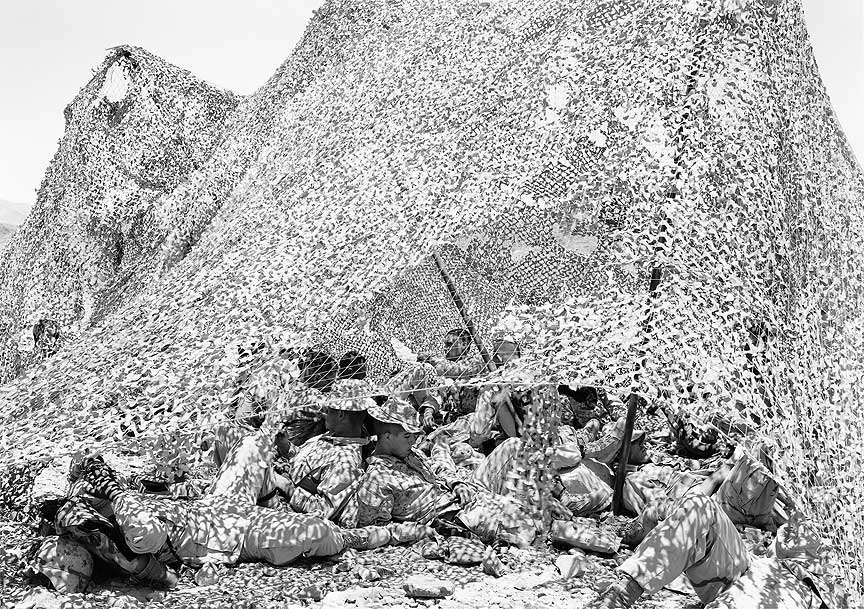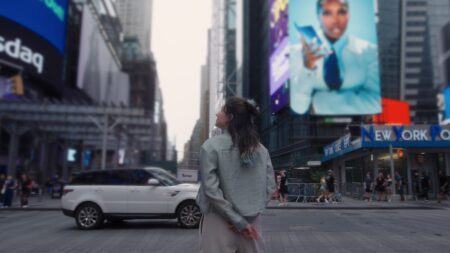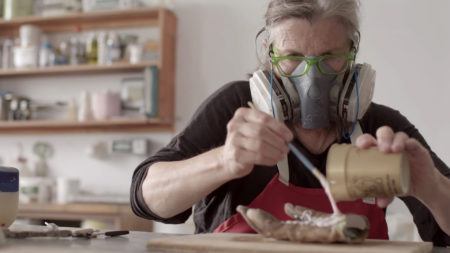Interview
War and Aesthetics

An-My Lê. Small Wars (lesson), 1999-2002. Gelatin silver print, 26 x 37 1/2 inches. Edition of 5. © An-My Lê. Courtesy of Murray Guy, New York.
Artist An-My Lê discusses her process of aestheticizing war, and the thinking behind her choice of black and white photography.
ART21: There must be a fine line between making a representation of war and aestheticizing it.
LÊ: The kind of work that I make is not the standard political work. It’s not agitprop. You would think, because I’ve seen so much devastation and lived through a war, that I should make something that’s outwardly antiwar. But I am not categorically against war. I was more interested in drawing people into my work, to think about the issues that envelop war—representations of war, landscape and terrain in war. When I’m working with the military, I still think of myself as a landscape photographer. My main goal is to try to photograph landscape in such a way that it suggests a universal history, a personal history, a history of culture. But I also wanted to address issues of preparation, moral and military. It drew me in, but at the same time it was repellent. I’m fascinated by the military structure, by strategy, the idea of a battle, the gear. But at the same time, how do you resolve the impact of it? What it is meant to do is just horrible.
But war can be beautiful. I think it’s the idea of the sublime—moments that are horrific but, at the same time, beautiful— moments of communion with the landscape and nature. And it’s that beauty that I wanted to embrace in my work. I think that’s why the work seems ambiguous. And it’s meant to be. War is an inextricable part of the history of high civilization; I think it’s here to stay. But I also think we need to try to avoid it as much as possible. I was not so interested in making work that you see on the news page, which has the effect of wanting you to condemn war immediately. I wanted to approach the idea in a more complicated and challenging way.
ART21: But the work is also a kind of protest.
LÊ: It is somewhat a condemnation of war. I think it was an awful mistake. And I think some of these marines and soldiers feel that it was a mistake. That’s something that I’ve learned about people who join the military, that it is a profession. Some of them have a natural [inclination] for it and want to join combat services, but for some it’s just a profession. Once they sign up, it is a job, and they want to do it well. So, no matter what happens, they give up their own decision-making and follow whatever the government decides. And they are just trying to finish that job. I think many of the marines and soldiers feel that we shouldn’t be there. Or maybe that what were trying to do has not really panned out.

An-My Lê. 29 Palms: Night Operations III, 2003-04. Gelatin silver print, 26 × 37 1/2 inches. Edition of 5. © An-My Lê. Courtesy of Murray Guy, New York.
ART21: There’s a quiet subtlety to your photographs of the Vietnam War reenactors. Why is that?
LÊ: The pictures of the reenactors shy away from some of the more subversive scenes that they performed—whether taking prisoners or their rough handling of the other camp. I didn’t find it fruitful to dwell on that or try to replicate some of the horrific moments that happened during the war. I stayed away from that, and obviously that comes from my personal background. But, with the help of the reenactors, this was a way to direct my own movie without having the means and potential to be my own director. I don’t have such a great imagination, so seeing certain things that they did inspired me. I was able to make a Vietnam War that was ultimately safe, a game. In that way, I was able to bring in my own experience.
ART21: Why have you’ve chosen black-and-white versus color photography for certain projects?
LÊ: Black-and-white was always my choice because of my interest in drawings. A black-and-white photograph is just more pronounced because it’s all about lines, and the changes are tonal, from grays to darker grays to blacks and to whites. So, drawing is conserved in the black-and-white palette. What’s interesting to me is the fact that color is removed somehow makes certain things more obvious. One is not distracted by the fact that it’s connected to real lives—or perhaps I should say that black-and-white is a little bit more removed from real life than color photography is. It is removed from reality; it’s its own thing. People talk about black-and-white and how it’s associated with memory, but that doesn’t really work for me. They also talk about it being old-fashioned or obsolete, but I think it is very contemporary. It’s so unlike anything else and so removed from reality that, if you use the right subject matter, it can be very powerful.
I thought of using color for the project on the military and the sea mostly because I was drawn to the way color would describe a gray on the hull of a ship versus a gray that’s more organic—the gray of the ocean at certain times of the day or the gray of the sky on an overcast day. I don’t think black-and-white could distinguish between a cold or metallic gray and something that may have a bit more warmth and that’s more organic. That’s my only reason for switching to color, and that’s a good instinct. I tend not to like garish things, so I have probably developed my own palette—which is black-and-white and color—perhaps. I’m learning and, over time, I think I’ll develop my own color palette.

An-My Lê. 29 Palms: Infantry Platoon, Alpha Company, 2003-04. Gelatin silver print, 26 × 37 1/2 inches. Edition of 5. © An-My Lê. Courtesy of Murray Guy, New York.
ART21: How does using a large-format camera impact the work?
LÊ: It’s the same camera I’ve been using since 1991, and it’s a very cumbersome camera. Because it’s so cumbersome, it makes me make a particular type of picture. It forces me to resolve certain questions. If you want to photograph something, and the camera is not suitable for it, how do you figure it out? How do you solve the problem? These questions came up, photographing military exercises. Of course, Timothy O’Sullivan did it in the nineteenth century during the Civil War, and other photographers like Roger Fenton did it, but it just seems unsuitable. So, how do you resolve those issues? I’m interested in what I have to go through to make it work. It forces me to make a particular type of pictures, and I like what it makes me do.
Working against the grain forces me to come up with new ways of resolving something, instead of being comfortable all the time. For instance, taking the camera on the ship was very difficult because of the ship’s movement. And one can easily compensate with a handheld camera, but how do you resolve that when you’re on a tripod, or when you want to photograph action with such a cumbersome camera? It just forces you to work in a different way.
ART21: Do you think there’s a built-in relationship between photography and the sublime?
LÊ: I think there’s always an element of something not quite understood in the sublime, something otherworldly, conflicting—something beautiful that’s not always beautiful, and something that’s not quite controllable and not within our reach. I don’t think that photography is made to capture and describe magic, but there are great magical moments in still photographs.
ART21: You seem to adapt easily to photographing in environments you are not necessarily a part of.
LÊ: I think the camera’s a pretext. I don’t think I would otherwise ever gain access to the military and learn about all these things. The camera is a pretext to allow me to get inside and learn about what it’s like to train as a Marine and live the life of a Marine. My interest in finding out about other groups of people has to do with a desire to belong to something. Because I’ve led such disjunctive life and I’ve moved around so much, I’m always testing my power to adapt. It’s difficult and it’s stressful, but I think there’s something of challenging and satisfying knowing that you can adapt.



